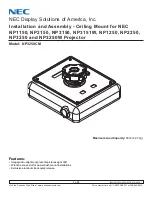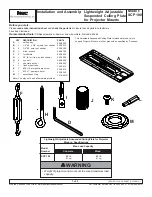
VRLA BATTERIES
AUGUST 2003
This information is generally descriptive only and is not intended to make or imply any representation, guarantee or warranty with respect to any cells and batteries. Cell and battery designs/specifications are subject
to modification without notice. Contact Panasonic for the latest information.
Precautions for handling Valve-Regulated
Lead-Acid Batteries
•
This document should be read in its entirety
and its contents fully understood before
handling or using Panasonic rechargeable
Valve-Regulated Lead-Acid batteries. If there
are any questions, please contact Panasonic.
Please keep this document available for
reference. Due to the potential energy stored
in the batteries, improper handling or use of
the batteries by not observing the precautions
listed in this document may result in bodily
injury caused by electrolyte leakage, heat
generation, or explosion.
* All descriptions are subject to modification without notice.
Degree of danger
1. DANGER
Indicates an imminently hazardous situation
which, if not avoided, will result in death or serious
injury.
2. WARNING
Indicates a potentially hazardous situation which, if
not avoided, could result in death or injury.
3. CAUTION
Indicates a potentially hazardous situation which, if
not avoided, may result in minor or moderate
injury, or damage to equipment.
4. RECOMMENDATION
Recommended course of action to prevent a situation
that could result in damage of quality, performance or
reliability of the batteries, should they be mishandled.
(Remark 1) Even in cases where lead-acid batteries
are handled improperly, a situation that
will result in the immediate death of the
user is highly unlikely. However, we have
assumed the higher DANGER level
situation instead of the WARNING and
CAUTION levels because the high
energy stored in batteries still implies a
possibility of extreme hazard which
might lead to serious injury.
(Remark 2) Serious injury here would include injury,
loss of eyesight, burns, electric shocks,
bone fractures and poisoning that will
cause permanent damage or require
hospitalization or intensive treatment
over an extended period. Minor injury
includes slight burns and electric shock.
Property damage means damage to
buildings and household effects includ-
ing livestock and pets.
(Remark 3) RECOMMENDATION refers to the
suggested means by which to protect
batteries from impaired quality, perfor-
mance and reliability.
PRECAUTIONS FOR HANDLING VALVE-REGULATED LEAD-ACID BATTERIES



























